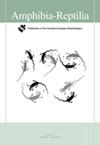An isolated crested newt population in Dutch coastal dunes: distribution relict or introduction?
IF 1.3
4区 生物学
Q3 ZOOLOGY
引用次数: 2
Abstract
Isolated distribution patches may represent local remnants of a formerly wider range or could have originated by human-mediated expansion beyond the natural range. Distinguishing between these two scenarios is not always straightforward. Northern crested newts (Triturus cristatus) in the Dutch coastal dunes are disconnected from the main species range by over 40 kilometres and whether they have been present historically is unclear. We genotyped crested newts from throughout the Netherlands for an mtDNA marker to determine the provenance of the coastal dune population. Because a closely related species, the Italian crested newt (T. carnifex), has an introduction history in the Netherlands, we also screened eight nuclear DNA SNP markers diagnostic for T. cristatus vs. T. carnifex. The crested newts from the coastal dunes carry a single T. cristatus mtDNA haplotype that naturally occurs in the south, but not the east, of the Netherlands. Therefore, we cannot distinguish if the population represents a natural distribution relict or is derived from an introduction. We find no evidence of genetic admixture with T. carnifex in the coastal dunes, but such admixture is apparent at another Dutch locality (far removed from a previously known genetically admixed population). Our study illustrates how difficult it can be to determine the origin of isolated populations.荷兰海岸沙丘中一个孤立的冠蝾螈种群:分布遗迹还是引进?
孤立的分布斑块可能代表以前更广泛范围的局部残余,或者可能起源于人类介导的超出自然范围的扩张。区分这两种情况并不总是那么简单。荷兰海岸沙丘上的北冠蝾螈(Triturus cristatus)与主要物种的分布距离超过40公里,历史上它们是否存在尚不清楚。我们对来自荷兰各地的冠蝾螈进行了基因分型,以确定海岸沙丘种群的来源。由于一个亲缘关系密切的物种,意大利冠蝾螈(T.carnifex),在荷兰有引入史,我们还筛选了八个核DNA SNP标记,用于诊断嵴蝾螈与肉蝾螈。来自海岸沙丘的冠蝾螈携带一个单一的嵴蝾螈mtDNA单倍型,这种单倍型自然出现在荷兰南部,但不在东部。因此,我们无法区分种群是代表自然分布的遗迹还是源自引进。我们在海岸沙丘中没有发现与肉毒T.carnifex基因混合的证据,但这种混合在荷兰的另一个地方很明显(与以前已知的基因混合种群相距甚远)。我们的研究表明,确定孤立种群的起源是多么困难。
本文章由计算机程序翻译,如有差异,请以英文原文为准。
求助全文
约1分钟内获得全文
求助全文
来源期刊

Amphibia-Reptilia
生物-动物学
CiteScore
3.10
自引率
6.20%
发文量
39
审稿时长
6-12 weeks
期刊介绍:
Amphibia-Reptilia is a leading European multi-disciplinary journal devoted to most of the aspects of herpetology: ecology, behaviour, evolution, conservation, physiology, morphology, paleontology, genetics, and systematics.
Amphibia-Reptilia publishes high quality original papers, short-notes, reviews, book reviews and news of the Societas Europaea Herpetologica (SEH). The Societas Europaea Herpteologica (SEH) website is located at: www.seh-herpetology.org.
 求助内容:
求助内容: 应助结果提醒方式:
应助结果提醒方式:


